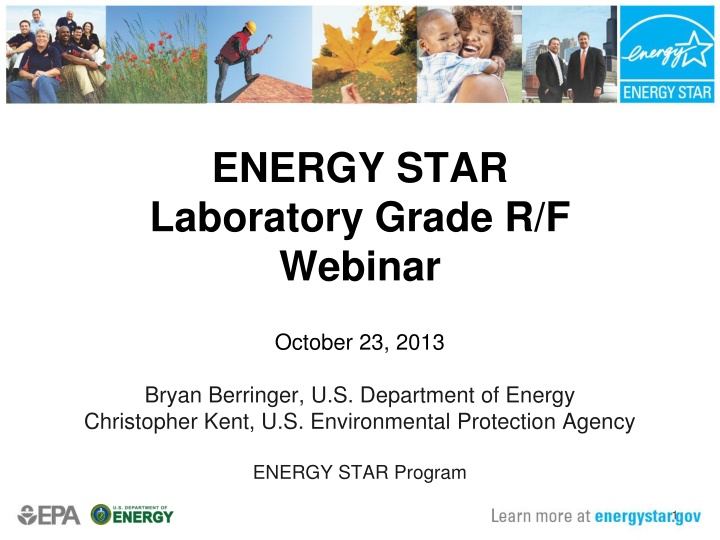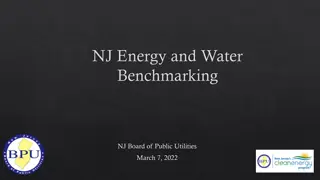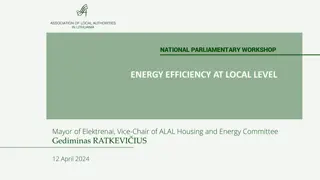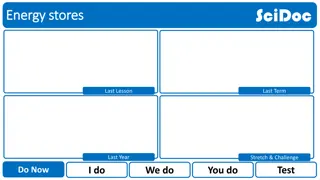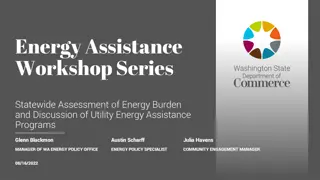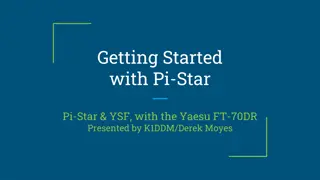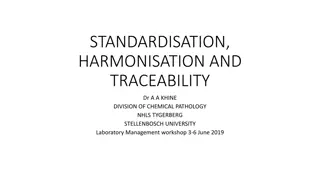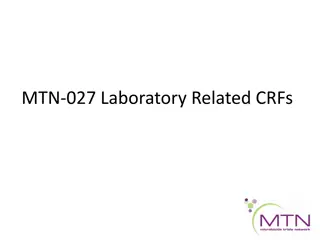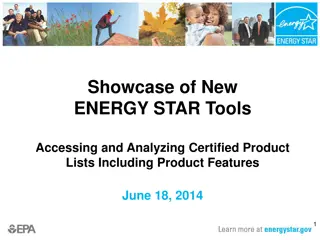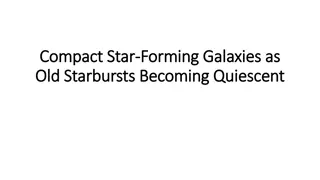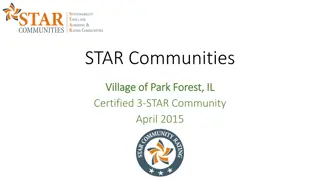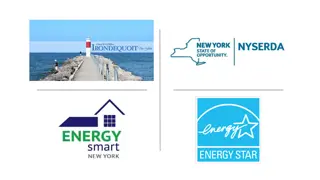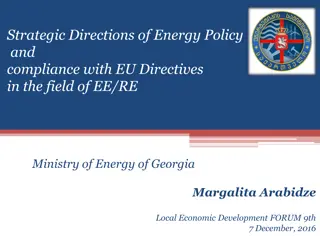ENERGY STAR Laboratory Grade R/F Webinar Summary
The ENERGY STAR Laboratory Grade R/F Webinar held on October 23, 2013, featured presentations by Bryan Berringer from the U.S. Department of Energy and Christopher Kent from the U.S. Environmental Protection Agency. The webinar covered topics such as DOE validation testing, test data analysis, draft test method updates, and stakeholder comments submission. Important areas of discussion included steady-state tolerance, door opening requirements, and the use of bare vs. weighted thermocouples. Stakeholders were encouraged to provide written comments by October 23, 2013, via email to labgraderefrigeration@energystar.gov. Audio for the webinar was provided via teleconference, and the presentation slides can be accessed on the ENERGY STAR website.
Download Presentation

Please find below an Image/Link to download the presentation.
The content on the website is provided AS IS for your information and personal use only. It may not be sold, licensed, or shared on other websites without obtaining consent from the author.If you encounter any issues during the download, it is possible that the publisher has removed the file from their server.
You are allowed to download the files provided on this website for personal or commercial use, subject to the condition that they are used lawfully. All files are the property of their respective owners.
The content on the website is provided AS IS for your information and personal use only. It may not be sold, licensed, or shared on other websites without obtaining consent from the author.
E N D
Presentation Transcript
ENERGY STAR Laboratory Grade R/F Webinar October 23, 2013 Bryan Berringer, U.S. Department of Energy Christopher Kent, U.S. Environmental Protection Agency ENERGY STAR Program 1
Webinar Details Webinar slides and related materials will be available on the Laboratory Grade R/F Web page: www.energystar.gov/newspecs Follow link to Version 1.0 is in Development under Laboratory Grade Refrigerators and Freezers Audio provided via teleconference: Call in: +1 (877) 423-6338 (U.S.) +1 (571) 281-2578 (International) Code: 356609# Phone lines will remain open during discussion Please mute line unless speaking Press *6 to mute and *6 to un-mute your line 2
Introductions Christopher Kent U.S. Environmental Protection Agency Bryan Berringer U.S. Department of Energy Erica Porras ICF International Kurt Klinke Navigant Consulting 3
Written Comments In addition to making verbal comments during today s call, stakeholders are encouraged to submit written comments to labgraderefrigeration@energystar.gov. Comment Deadline Wednesday, October 23, 2013 4
Webinar Objectives Provide overview of DOE validation testing Present relevant test data, analysis, and conclusions Review additional changes from Draft 1 to Draft 2 Test Method 5
Agenda 1 DOE Validation Testing 2 Additional Draft 2 Test Method Updates 3 Next Steps 6
Draft 1 Test Method Overview Draft 1 Test Method was published Sept. 28, 2012, with comments due Oct. 31, 2012 Webinar held Nov. 8, 2012 DOE received significant comments regarding three major issues: Steady State tolerance Door opening requirements Bare vs. weighted thermocouples (TC) 7
DOE Validation Testing Based on comments, DOE decided to perform validation testing Several tests performed to evaluate each major issue commented on by stakeholders Steady State tolerance Door opening requirements Bare vs. weighted TCs 8
DOE Validation Testing Testing performed at a manufacturer lab Testing performed on four units Unit # Unit Type Configuration 1 Lab Grade Freezer Upright 2 Lab Grade Refrigerator Upright 3 Ultra-Low-Temp Freezer Chest 4 Ultra-Low-Temp Freezer Upright Units set up per Draft 1 Test Method requirements except Both bare and weighted TCs used Weighted TCs placed in 10 mL vial with 50/50 mix of glycol/water 9
Steady State Tolerance Testing Draft 1 Test Method stated that units must reach Steady State prior to testing Steady State: The condition where the average temperature of all TCs changes less than 0.2 C (0.4 F) from one 24-hour period or refrigeration cycle to the next. Stakeholders commented that 0.2 C was too stringent and suggested several other tolerance levels 10
Steady State Tolerance Testing Steady State tolerance test: Units set to Draft 1 Test Method set point temperature Units run continuously for at least 48 hours No door openings Temperature and power measurements taken every minute Average Cabinet Temperature and power draw calculated for each 24-hour period of measurement 11
Steady State Tolerance Testing Steady State tolerance data: Temperature all values in C Unit # Max 24-hour Average Bare Min 24-hour Average Bare Variation TC Type Weighted Weighted Bare Weighted 1 2 3 4 -29.81 4.16 -80.61 -79.73 -29.87 4.36 -80.05 -79.92 -30.13 4.12 -80.72 -79.94 -30.15 4.33 -80.18 -80.12 0.32 0.04 0.11 0.21 0.28 0.03 0.13 0.20 Not all units could maintain temperature within 0.2 C regardless of TC type 12
Steady State Tolerance Testing Steady State tolerance data: DOE also evaluated variation in average power draw for all 24-hour periods Overall Avg Power Draw (kW) 0.678 0.096 0.706 0.555 Standard Deviation (kW) 0.019 0.002 0.004 0.013 Unit # COV* 1 2 3 4 2.7% 1.6% 0.6% 2.4% *COV Coefficient of Variation The ratio of the Standard Deviation to the Average Maximum variance in average power draw was < 3% 13
Steady State Tolerance Testing Testing showed: Not all units could remain within 0.2 C Small variations in average temperature did not result in significant changes in power draw Based on testing, DOE has proposed to increase Steady State tolerance to 0.5 C Reduces test burden by making Steady State easier to achieve Does not significantly affect overall variation in energy consumption of unit 14
Door Opening Requirements Testing In Draft 1, DOE requested stakeholder feedback regarding the door opening (DO) requirements DOE received widely varying comments, including: DOs should not be included and a higher ambient temp should be used to simulate door openings for ULFs DO methods not representative of normal operation for all unit types DOs may negatively affect repeatability Agreement with including DOs 15
Door Opening Requirements Testing Based on comments, DOE performed testing to evaluate DO DOE performed three different tests: Two using different DO patterns on each unit One with no DOs in higher ambient temp (32 C) High ambient test only performed on ULF units Comments specifically suggested this test for ULFs only 16
Door Opening Requirements Testing Doors opened 1x per hour for 8 hours Tests performed over two days Individual door openings and closings performed over a constant rate of 2 seconds Units w/ Inner Doors Units w/ Drawers Day 1 Open outer door and top inner door Wait 7 seconds Close both doors Use same inner door for each door opening Open outer door and top inner door Wait 7 seconds Close both doors Alternate inner door used for each door opening Open main door Wait 7 seconds Close main door Drawers left in closed position Day 2 Open main door and top drawer Wait 7 seconds Close drawer and main door Alternate drawer used for each opening 17
Door Opening Requirements Testing DOE tested units 3 and 4 in a higher ambient temp (32 C vs. 25 C) Higher ambient temp meant to simulate increased load created by door openings Length of door openings difficult to make repeatable Units allowed to reach Steady State Power measured over course of 8 hours No door openings 18
Door Opening Requirements Testing To evaluate each DO pattern DOE calculated The average power consumption for each one hour period and the entire eight hour period The standard deviation of all eight single-hour periods during which a door was opened The Coefficient of Variation (COV, the ratio of standard deviation to the average power) for all eight single-hour periods DOE also compared the overall averages to the average power measured at higher ambient for the two ULFs 19
Door Opening Requirements Testing Comparison of Door Opening Patterns Unit 1 Unit 2 Unit 3 Unit 4 Day 1 0.767 0.037 4.80% Day 2 0.826 0.041 4.91% Day 1 0.096 0.003 3.63% Day 2 0.095 0.005 6.07% Day 1 0.715 0.018 2.59% Day 2 0.731 0.014 1.97% Day 1 0.647 0.015 2.30% Day 2 0.641 0.016 2.49% Average (kW) Std. Dev. (kW) COV Comparison of Normal vs. High Ambient Temp Unit # Average Power Consumption (kW) Day 1 DO Day 2 DO 0.715 0.731 0.647 0.641 High Amb. 0.917 0.590 3 4 20
Door Opening Requirements Testing Testing showed that both DO patterns provided relatively consistent results for each 1-hour period The Day 1 pattern was more consistent than Day 2 COV < 5% across all units High Ambient Temp testing showed no correlation with the DO tests 21
Door Opening Requirements Testing Based on this testing, DOE Does not believe testing at a higher ambient temp to be a valid method of simulating DOs Believes that door openings can be performed and provide consistent results As such, DOE has proposed to continue including door opening requirements using the Day 1 pattern 22
Bare vs. Weighted TCs In the Draft 1 Test Method, DOE specified using bare, unweighted TCs DOE requested feedback regarding the use of bare vs. weighted TCs Stakeholders commented that staying within specified Set-Point Temperature tolerances would be difficult with bare TCs Based on these comments, DOE performed all testing with both bare and weighted TCs Weighted TCs placed in 10 mL vials filled with a 50/50 glycol/water mixture 23
Bare vs. Weighted TCs DOE compared the average Cabinet Temperature over the course of each test Both 8-hour DO tests 48-hour Steady State test Testing showed minimal variation between TCs Average of 0.29 C difference As such, DOE has proposed to continue using bare TCs for all testing Both types of TCs provide similar values Reduces test setup burden compared to using weighted TCs 24
Bare vs. Weighted TCs Data comparison between TC types for average Cabinet Temperature over course of each test All values in C Unit 1 DO Day 1 DO Day 2 Steady State Weighted -30.221 -30.391 -29.872 Bare -30.197 -29.983 -29.961 Difference 0.024 0.409 0.089 Unit 2 DO Day 1 DO Day 2 Steady State Weighted 4.214 4.351 4.344 Bare 4.044 4.156 4.136 Difference 0.170 0.195 0.208 25
Bare vs. Weighted TCs Data comparison between TC types for average Cabinet Temperature over course of each test All values in C Unit 3 DO Day 1 DO Day 2 Steady State Weighted -79.836 -79.945 -80.121 Bare -80.441 -80.494 -80.675 Difference 0.605 0.549 0.554 Unit 4 DO Day 1 DO Day 2 Steady State Weighted -77.973 -77.922 -80.027 Bare -77.759 -77.604 -79.833 Difference 0.214 0.318 0.194 26
Additional Comments Additional Comments? Written Comments are due by October 23 27
Agenda 1 DOE Validation Testing 2 Additional Draft 2 Test Method Updates 3 Next Steps 28
Additional Draft 2 Updates DOE made additional updates to the Draft 2 Test Method regarding the following topics Ambient Test Conditions Volume Measurement Requirements Defrost Adequacy Test Reporting Requirements 29
Ambient Test Conditions In the Draft 1 Test Method, DOE included lighting and radiant heat ambient condition requirements Draft 1 Requirements based on ASHRAE 72 Stakeholders commented that these requirements were unnecessary and increased burden Lighting and radiant heat have no noticeable effect on unit energy consumption 30
Ambient Test Conditions After further evaluation, DOE does not believe these requirements are applicable to Lab Grade R/F As such, DOE has proposed to remove the lighting and radiant heat requirements Requirements do not affect Lab Grade R/F Reduces test burden by easing the preliminary test setup requirements for labs 31
Volume Measurement Requirements After publication of Draft 1, DOE reevaluated the volume measurement requirements Requirements were not based on known industry standards Based on its evaluation, DOE has proposed to update the volume measurement requirements to reference ANSI/AHAM HRF- 1-2008 Common industry standard used for R/F Provides standardized method of determining volume 32
Volume Measurement Requirements Stakeholders also requested that CAD drawings be allowed when determining net useable volume DOE agrees that CAD drawings be allowed If used, all measurements and calculations must meet HRF-1-2008 s requirements As such, DOE has proposed to update the requirements to allow the use of CAD drawings 33
Defrost Adequacy Assurance Test The Draft 1 Test Method included a test to evaluate the adequacy of any automatic defrost DOE received multiple stakeholder comments agreeing that the test: Is extremely subjective Significantly increases total test time After evaluation, DOE agrees with the stakeholder comments and has proposed to remove the test DOE requests feedback regarding alternative methods 34
Reporting Requirements DOE received stakeholder comments requesting the reporting of additional values Uniformity Stability Peak Variance DOE agreed with stakeholder comments and has proposed requiring the reporting of the listed values Values are calculated for a 3-hour period, not including any part of the 8-hour DO period 35
Reporting Requirements Uniformity: The difference between the maximum and minimum temperature measured inside of a unit s cabinet at any given time Stability: The difference between the maximum and minimum temperature measured by a given thermocouple over the course of the entire test period Peak Variance: The difference between the maximum and minimum temperatures measured across all thermocouples over the course of a given measurement period 36
Additional Comments Additional Comments? Written Comments are due by October 23 37
Agenda 1 DOE Validation Testing 2 Additional Draft 2 Test Method Updates 3 Next Steps 38
Test Method Development Timeline Draft 2 Version 1.0 Test Method to stakeholders September 2012 Draft 2 Version 1.0 Test Method comments due October 2012 Draft 3 Version 1.0 Test Method to stakeholders (if needed) December 2013 Draft 3 Version 1.0 Test Method comments due January 2014 Final Draft Version 1.0 Test Method to stakeholders Spring 2014 Final Draft Version 1.0 Test Method comments due Spring 2014 Final Version 1.0 Test Method Summer 2014 39
Written Comments In addition to making verbal comments during today s call, stakeholders are encouraged to submit written comments to labgraderefrigeration@energystar.gov. Comment Deadline Wednesday, October 23, 2013 40
Contact Information Please send any additional comments to labgraderefrigeration@energystar.gov or contact: Bryan Berringer DOE ENERGY STAR Program Bryan.Berringer@ee.doe.gov Kurt Klinke Navigant Consulting, Inc. Kurt.Klinke@navigant.com Thank you for participating! Christopher Kent EPA ENERGY STAR Program Kent.Christopher@epa.gov Erica Porras ICF International Erica.Porras@icfi.com www.energystar.gov/productdevelopment 41
